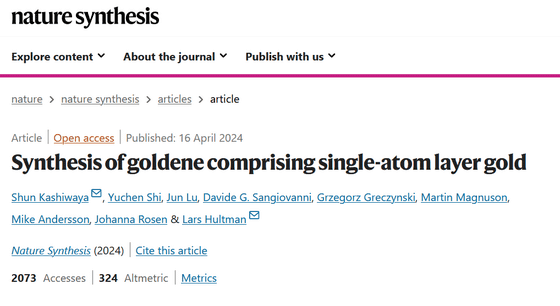Successful synthesis and isolation of 'golden' gold sheets one atom thick, expected to be applied to electronic circuits and catalysts

Graphene, a sheet-like material made of only carbon with a thickness of one atom, is expected to be a new material of the future because of its extremely high material strength, thermal conductivity, and electrical conductivity. A research team at Linköping University has reported that they have succeeded in producing and isolating a gold sheet called ' Goldene,' which is just one atom thick like graphene.
Synthesis of goldene comprising single-atom layer gold | Nature Synthesis

A single atom layer of gold – LiU researchers create goldene – Linköping University
https://liu.se/en/news-item/ett-atomlager-guld-liu-forskare-skapar-gulden

Meet 'goldene': this gilded cousin of graphene is also one atom thick
https://www.nature.com/articles/d41586-024-01118-0
Many scientists have pursued two-dimensional materials similar to graphene, but it has been very difficult to create two-dimensional materials made of metal atoms because metal atoms always tend to cluster together into nanoparticles .
A study published in 2015 reported a two-dimensional material of tin atoms, and a study in 2019 (PDF file) reported a two-dimensional material of lead atoms. This time, the research team at Linköping University announced 'the first two-dimensional material of independently standing gold atoms,' which the research team named 'Goldene' after graphene.
To make GOLDEN, Linköping University created a material that sandwiched a monolayer of silicon between layers of titanium carbide. When gold was added on top of this layered structure, the gold atoms diffused into the structure, replacing the silicon, creating a monolayer of gold.

After that, only the titanium carbide is removed to extract the golden nanoparticles. The technology to remove the titanium carbide is based on a Japanese forging technique called '
'The sheet-like material, the golden, is in solution, a bit like corn flakes in milk,' Kashiwaya said. 'We'll collect it using a type of sieve and then examine it under an electron microscope to see if we've been successful.'
With gold nanoparticles showing promise in fields such as electronics, catalysis, photonics, sensing and biomedicine, the team suggests that golden could be similarly useful.

For example, gold nanoparticles have the optical property of transitioning electrons to a high-energy state when they absorb light, and this property is being used to develop photocatalysts that split water to produce hydrogen. In addition, if gold can be mass-produced, it may be possible to significantly reduce the amount of gold used in various situations.
The research team says that the golden material they have created may open up new possibilities, but there are many aspects of its properties that remain unknown, and further research is needed. They also plan to investigate whether they can create two-dimensional materials using the same method as golden material using other precious metals, such as platinum and silver.
Related Posts:
in Science, Posted by log1i_yk







